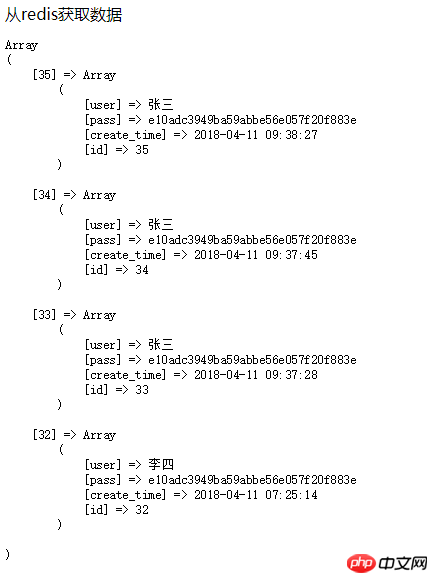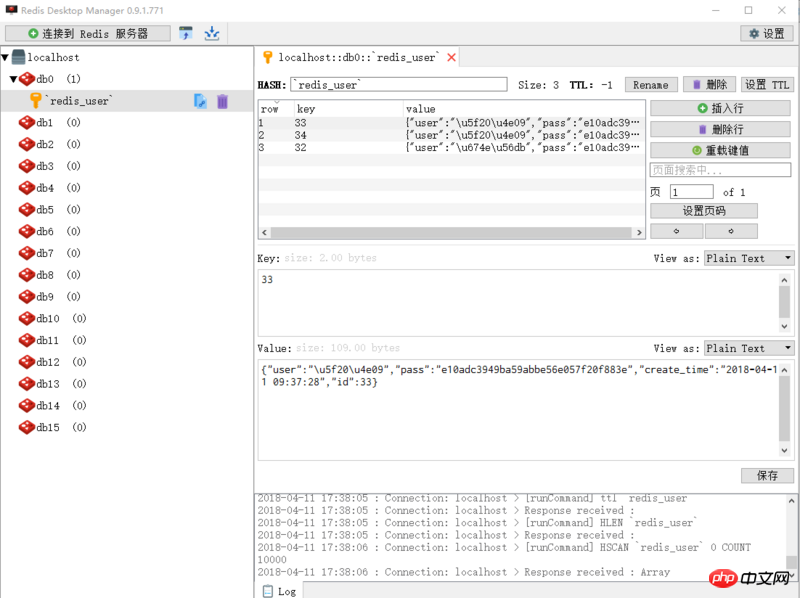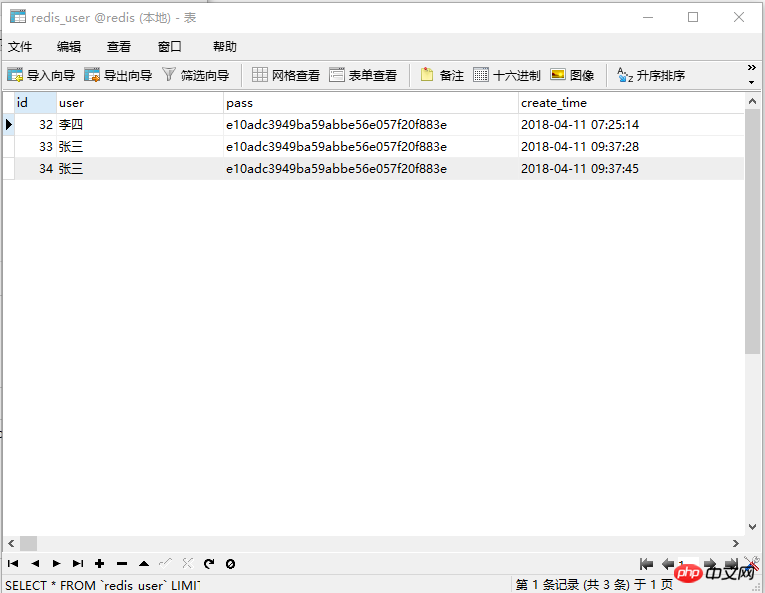
Der Inhalt dieses Artikels soll Ihnen die Einführung und einfache Anwendung von PHP und Redis vermitteln. Er hat einen gewissen Referenzwert.
1. Experimentelle Umgebung: win10 + redis3 .2 + php7
2. Installation von PHP-Redis / Redis / Redis-Grafikverwaltungstools, überspringen Sie diesen Schritt
3 häufig verwendeter Redis-Datentyp, keine detaillierte Erklärung
Referenz: http://www.runoob.com/redis/r...
4. PHP + MySQL + Redis einfache Anwendung
Datenbankname: redis Datentabelle: redis_user
PHP-Betrieb mysql + redis CURD-Betrieb simulieren
1. config.php-Konfigurationsdatei
<?php
$config = array(
'mysql'=>array(
'host'=>'127.0.0.1',
'user'=>'root',
'pass'=>'root',
'dbname'=>'redis',
'prefix'=>'redis_'
),
'redis'=>array(
'host'=>'127.0.0.1',
'port'=>6379
)
);index.php-Eintragsdatei , Wenn Sie MySQL betreiben, verwenden Sie bitte die Primärschlüssel-ID
<?php reqiure_once('Mysql.php'); //增加数据 // echo Mysql::getInstance()->table('user')->insert(['user'=>'张三','pass'=>md5('123456'),'create_time'=>date('Y-m-d H:i:s')]); //删除数据 // echo Mysql::getInstance()->table('user')->where(array('id'=>30))->delete(); //查看单条数据 // $data = Mysql::getInstance()->table('user')->where(array('id'=>'30'))->find(); // print_r($data); //查找所有数据 // $all = Mysql::getInstance()->table('user')->field('id,user')->select(); $all = Mysql::getInstance()->table('user')->select(); print_r($all); //修改数据 // echo Mysql::getInstance()->table('user')->where(array('id'=>30))->update(['user'=>'张三adfadfasdf11111111','pass'=>md5('123456aaa')]); ?>



Mysql.php-Datenbank und Redis-Betriebsdatei
<?php
class Mysql
{
static $instance;
private $conn;
private $redis;
private $options = array();
//单例模式
private function __construct()
{
error_reporting(E_ALL^E_NOTICE^E_WARNING);
require_once(__DIR__.'/Config.php');
$conn = mysqli_connect($config['mysql']['host'],$config['mysql']['user'],$config['mysql']['pass'],$config['mysql']['dbname']);
if(mysqli_connect_errno($conn)) {
echo "连接Mysql失败:".mysqli_connect_error();
exit;
}
mysqli_query($conn,'set names utf8');
$this->options['prefix'] = $config['mysql']['prefix'];
$this->conn = $conn;
$this->redis = new Redis();
$this->redis->connect($config['redis']['host'],$config['redis']['port']);
}
//获取对象实例
static function getInstance()
{
if(self::$instance) {
return self::$instance;
} else {
self::$instance = new self();
return self::$instance;
}
}
//设置表名
public function table(string $table)
{
$this->options['table'] = '`'.$this->options['prefix'].$table.'`';
return $this;
}
//设置redis键名
public function redis(string $key)
{
$this->options['key'] = $key;
return $this;
}
//设置条件
public function where(array $where)
{
$condition = '';
$and = count($where) > 1 ? ' and ' : '';
foreach ($where as $key => $value) {
if($key == 'id') {$this->options['user_id'] = $value;}
if(strpos($key,':')) {
$arr = explode(':', $key);
$condition .= '`'.$arr['0'].'` '.$arr['1']. ' "'.$value.'" ' . $and ;
} else {
$condition .= '`'.$key.'` = ' .'"'.$value.'"' .$and ;
}
}
$this->options['where'] = rtrim($condition,' and ');
return $this;
}
//设置字段
public function field(string $field)
{
$this->options['field'] = $field;
return $this;
}
//增加数据
public function insert(array $data)
{
$key = '`'.implode('`,`', array_keys($data)).'`';
$value = '"'.implode('","', $data).'"';
$sql = "insert into {$this->options['table']} (".$key.") values (".$value.");";
if( mysqli_query($this->conn,$sql) ) {
$user_id = $this->conn->insert_id;
$data['id'] = $user_id;
//以hash类型存储
$this->redis->hset($this->options['table'],$user_id,json_encode($data));
return $user_id;
} else {
return 0;
}
}
//删除数据
public function delete()
{
$where = $this->options['where'] ? $this->options['where'] : '1';
$sql = "delete from {$this->options['table']} where {$where};";
if(mysqli_query($this->conn,$sql)) {
$this->redis->hdel($this->options['table'],$this->options['user_id']);
return 1;
} else {
return 0;
}
}
//修改数据
public function update(array $data)
{
$condition = '';
$where = $this->options['where'] ? $this->options['where'] : '1';
foreach ($data as $key => $value) {
$condition .= ", `".$key."` = '".$value."'";
}
$condition = substr($condition, 1);
$sql = " update {$this->options['table']} set {$condition} where {$where} ; ";
if(mysqli_query($this->conn,$sql)) {
$hashData = (array)json_decode($this->redis->hget($this->options['table'],$this->options['user_id']));
foreach ($data as $key => $value) {
$hashData[$key] = $value;
}
$this->redis->hset($this->options['table'],$this->options['user_id'],json_encode($hashData));
return 1;
} else {
return 0;
}
}
//查找单条数据
public function find()
{
$field = $this->options['field'] ? $this->options['field'] : '*';
$where = $this->options['where'] ? $this->options['where'] : '1';
if($this->options['user_id']) {
echo '从redis获取数据<pre class="brush:php;toolbar:false">';
$data = (array)json_decode($this->redis->hget($this->options['table'],$this->options['user_id']));
if($field != '*') {
$field = explode(',', $field);
foreach ($field as $value) {
$arr[$value] = $data[$value];
$arr['typ'] = 'redis';
}
return $arr;
}
return $data;
} else {
$sql = " select {$field} from {$this->options['table']} where {$where}; ";
if($query = mysqli_query($this->conn,$sql)) {
return mysqli_fetch_assoc($query);
} else {
return array();
}
}
}
//查找所有数据
public function select()
{
$data = array();
$field = $this->options['field'] ? $this->options['field'] : '*';
$hashData = $this->redis->hgetall($this->options['table']);
if($hashData) {
if($field != '*') {
$field = explode(',', $field);
}
foreach ($hashData as $key => $value) {
$data[$key] = array();
$values = (array)json_decode($value);
if($field != '*') {
foreach ($field as $k => $v) {
$data[$key][$v] = $values[$v];
}
}else{
$data[$key] = $values;
}
}
echo '从redis获取数据<pre class="brush:php;toolbar:false">';
} else {
$sql = " select {$field} from {$this->options['table']} ; ";
if($query = mysqli_query($this->conn,$sql)) {
while ($row = mysqli_fetch_assoc($query)) {
$data[] = $row;
}
}
}
return $data;
}
public function __destruct()
{
mysqli_close($this->conn);
}
}Das obige ist der detaillierte Inhalt vonErste Schritte mit PHP plus Redis und einfachen Anwendungen. Für weitere Informationen folgen Sie bitte anderen verwandten Artikeln auf der PHP chinesischen Website!
 So öffnen Sie eine PHP-Datei
So öffnen Sie eine PHP-Datei
 So entfernen Sie die ersten paar Elemente eines Arrays in PHP
So entfernen Sie die ersten paar Elemente eines Arrays in PHP
 Was tun, wenn die PHP-Deserialisierung fehlschlägt?
Was tun, wenn die PHP-Deserialisierung fehlschlägt?
 So verbinden Sie PHP mit der MSSQL-Datenbank
So verbinden Sie PHP mit der MSSQL-Datenbank
 So verbinden Sie PHP mit der MSSQL-Datenbank
So verbinden Sie PHP mit der MSSQL-Datenbank
 Häufig verwendete Datenbanksoftware
Häufig verwendete Datenbanksoftware
 So laden Sie HTML hoch
So laden Sie HTML hoch
 So lösen Sie verstümmelte Zeichen in PHP
So lösen Sie verstümmelte Zeichen in PHP




